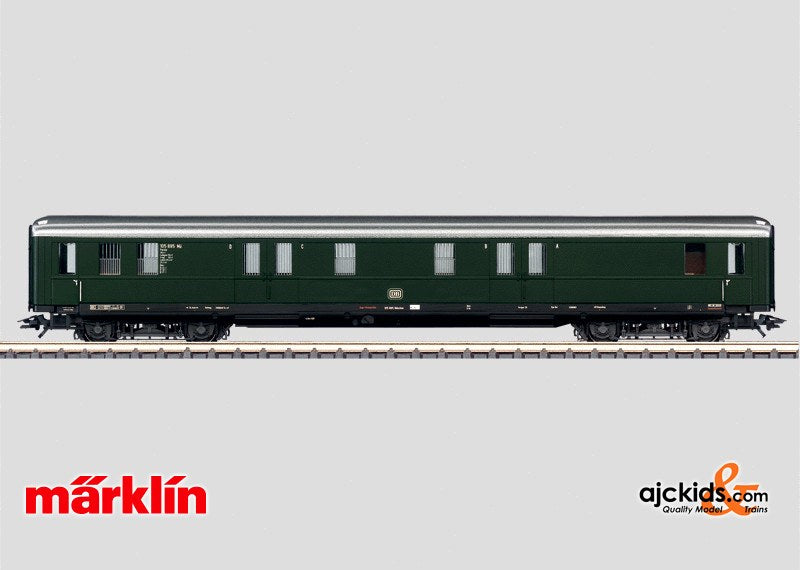Marklin 49964 - Sound Effects Car for Diesel Locomotives
Prototype: German Railroad, Inc. (DB AG) type 100 crane car with a type 817 boom tender car. 160 metric ton capacity. Assigned to Fulda. The cars look as they did in 1997.
Model: The car set has an mfx+ digital decoder and sound functions. The car set has the Surrounding Sound of hammering, Surrounding Sound 1 of abrasive cutting, Surrounding Sound 2 of a compressor, and Surrounding Sound 3 of a warning horn. The superstructure with the boom on a prototypical crown gear can be rotated. The boom can be raised and lowered by means of a pulley and double block and tackle. The metal main hook can be raised and lowered with pulley and double block and tackle. 4 support arms can be swung out manually and can be fixed with spindles on the bases included with the crane car. The crane car has a metal 8-axle car frame and superstructure. It has metal counter weights that can be mounted on the crane. The maximum length of the superstructure with boom and counterweights is 34 cm / 13-3/8". The radius range of the hook is up to 21 cm / 8-1/4". On curves, the boom can swing to the side prototypically during transport. The crane tender car is for supporting the boom and for storing the hooks and the support bases (stacks of ties). The counterweight car has special equipment for the transport and assembly of the counterweights. Lifting equipment for lifting objects with a maximum weight of 250 grams / 8.82 ounces is included with the model. This model is being delivered with a numbered certificate of authenticity.
Total length over the buffers 55 cm / 21-5/8".
Charlie's Tip: 49955 is the perfect add on set for the 49954 - Type 100 Crane Car with a Type 817 Boom Tender Car and a Counterweight Car
Maintenance and expansion of a rail network are essential for smooth railroad operations. Replacing turnouts, cutting back overgrown trees, or rerailing cars are among the work required for smooth operation. After accidents locomotives and cars must be salvaged, rubble has to be removed, and rescue work has to be done quickly and efficiently often under enormous time constraints. The railroad therefore needs cranes that have been adapted especially to its requirements. Between 1975 and 1977, the German Federal Railroad (DB) took delivery of three type 100 eight-axle diesel hydraulic railroad rotary cranes from Krupp Crane Construction, Inc. (formerly Krupp-Ardelt) in Wilhelmshaven. These units have 150 metric tons lifting power, and they attracted a great deal of attention in industry circles due to their design and drive system technical development. These crane cars were the most powerful on the DB at the time. They had long booms that were set up with cables and they were designed especially for cleanup work at serious accidents as well as for assembling bridge parts and for loading extremely heavy loads. An appropriately large support base (7.1 meters / 23 feet 4 inches) hat to be created here by mounting both counterweights and by swinging the support arms out at right angles. Then about 45 metric tons could be raised at the main hoist with maximum extension of the crane boom at 16.4 meters / 53 feet 10 inches and even 150 metric tons with a minimum extension of 8.0 meters / 26 feet 3 inches. The crane car rests on two four-axle trucks (4.5 meter / 14 feet 9 inches wheelbase) with roller bearing mounted 30 metric ton wheel sets. The inner wheel sets for each truck have a wheel set gearbox for self-propulsion, which is done with hydraulic axial piston motors. An air-cooled eight-cylinder Deutz diesel motor with 122 kilowatts / 163 horsepower continuous output at 1,800 rpm powers the drive system. This 160 metric ton heavy crane car has a maximum speed of 100 km/h / 63 mph and can operate on curves with a minimum radius of 120 meters / 40 feet. The crane boom rests on an approximately 20 meter / 66 foot long type 817 crane tender car when the crane is being transported somewhere to be used. The crane tender car runs on two trucks, each with two wheel sets, and it is also designed for 100 km/h / 63 mph.
EAN/UPC: 4001883499642



